Featured image:
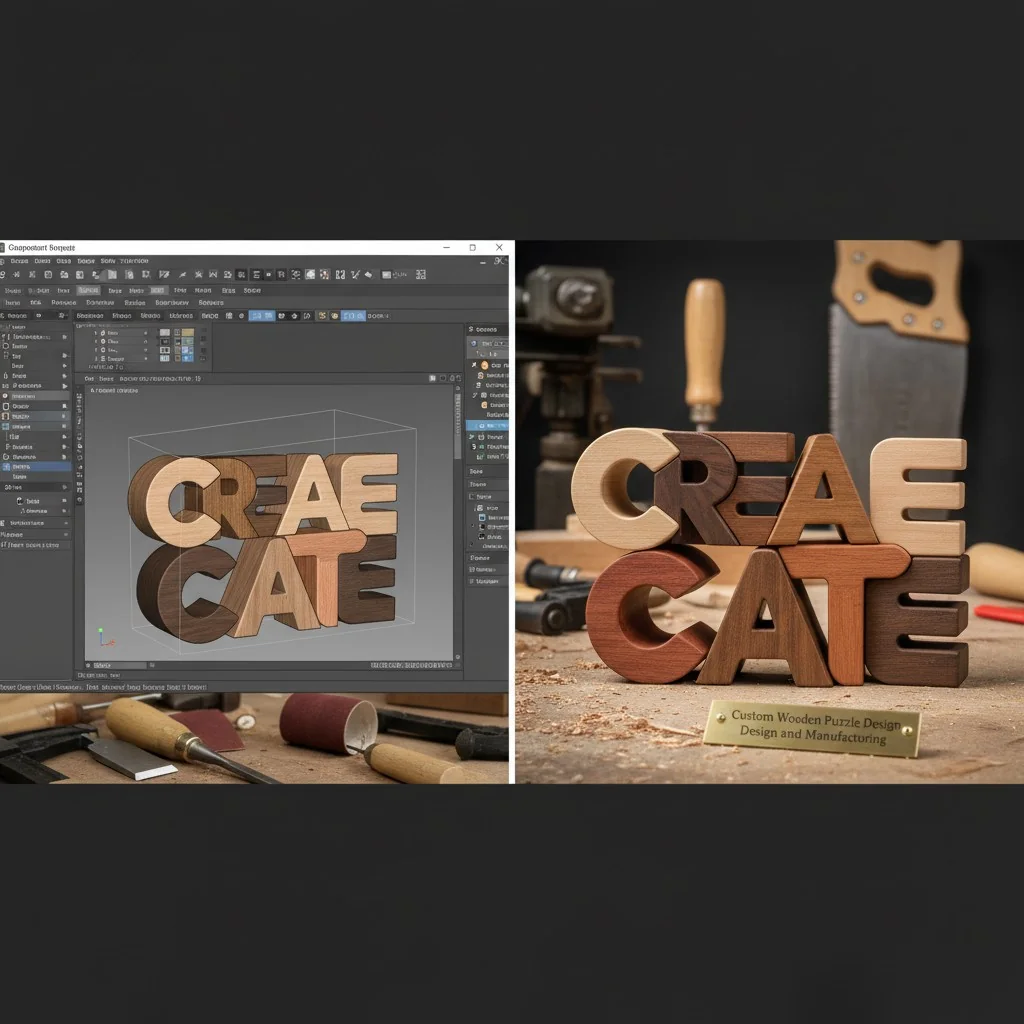
Struggling to apply your design skills to a new material like wood? A client wants a custom wooden toy[^1], but you're a plastics expert. I'll show you how to succeed.
To custom-manufacture a wooden stackable puzzle from China, you must first adapt your design for wood production. Then, you need to find and vet reliable toy manufacturers, provide a detailed technical package, approve prototypes, and manage quality control. My experience can guide you through each step.
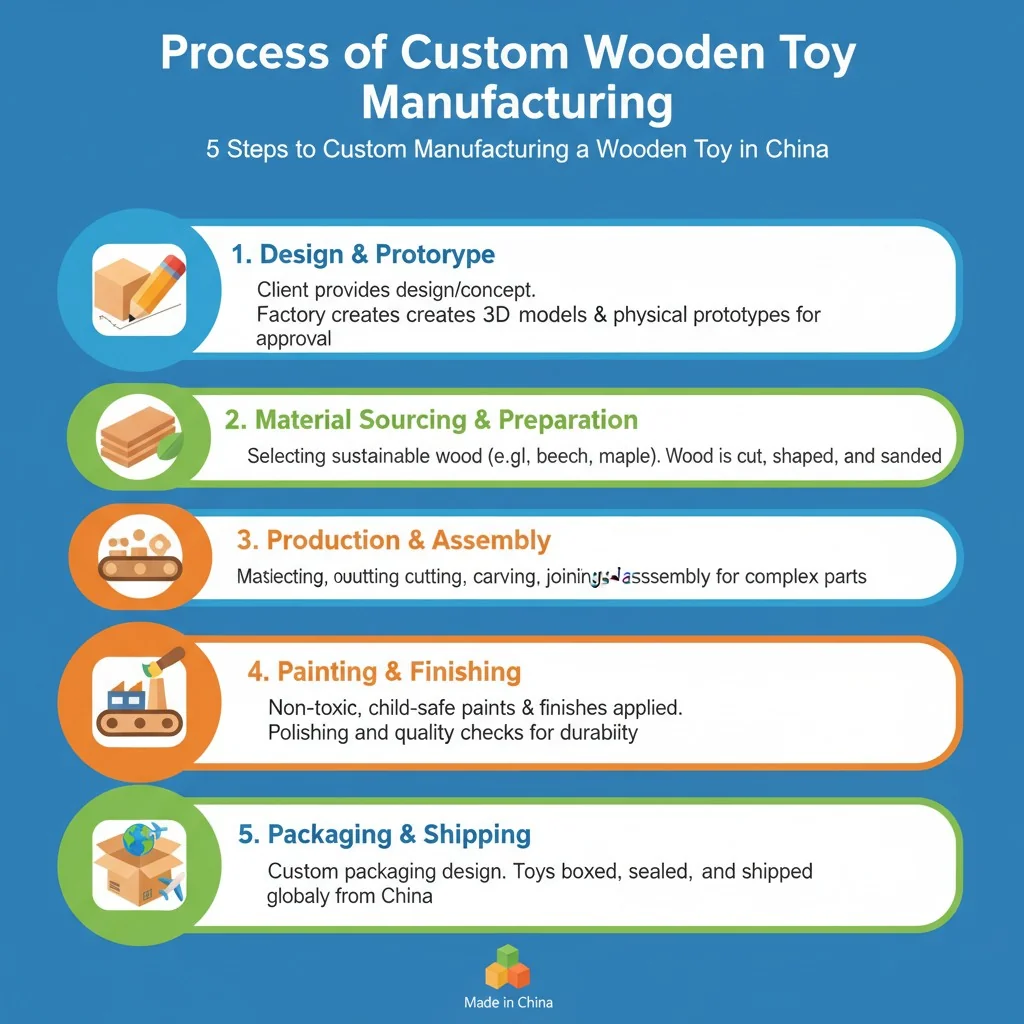
Transition Paragraph:
I know what you might be thinking. "Mike, you're the mold guy. We talk about plastic injection, shrinkage rates, and steel cores. Why are we talking about wooden toys?" It's a fair question. But through my trading company, I've sourced and managed production for all sorts of products, not just molded ones. The principles of good design for manufacturing[^2] (DFM) and supplier management are universal. A great designer like you can apply your skills anywhere with the right guidance. Let's look at how the developmental goals of a toy like this directly influence your design and manufacturing choices.
All wooden toys from China are made from bamboo.False
While bamboo is a popular, sustainable choice, many other woods like beech, pine, and basswood are commonly used depending on the toy's requirements for durability, weight, and finish.
EN71 is a key safety standard for toys sold in the European Union.True
The EN71 standard specifies safety requirements for toys, covering mechanical properties, flammability, and chemical migration, including limits on heavy metals in paints and finishes.
How Can Your Design Enhance Fine Motor Coordination?
Your design looks great on screen, but does it actually help a child develop? A toy that isn't designed for a child's hands is a missed opportunity for real developmental play.
To boost fine motor skills[^3], your design should include pieces with different shapes, sizes, and ways to be held. Add parts that need twisting, turning, or careful placement. This challenges a child's pincer grasp and hand-eye coordination, making the toy a tool for growth.
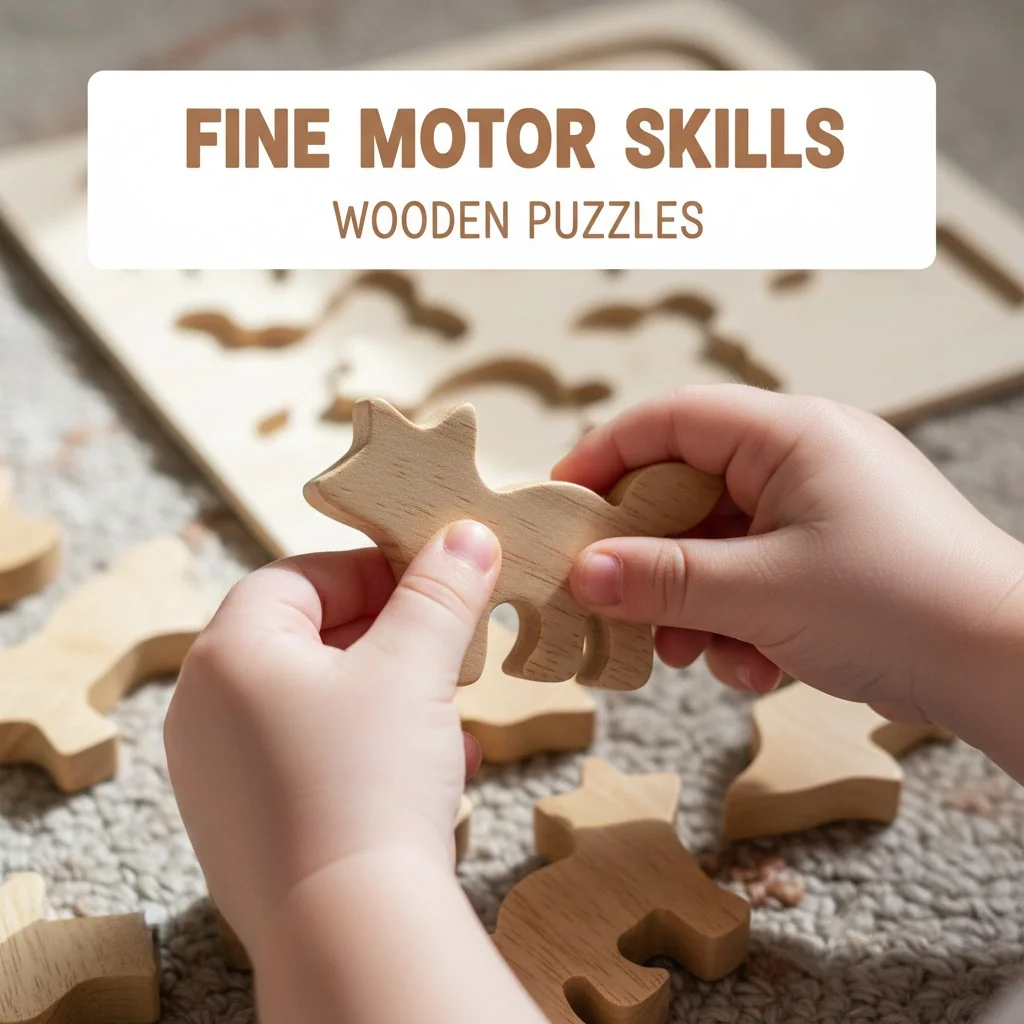
Dive deeper Paragraph:
When I work with clients on toy designs, the first thing we discuss is the target age. This determines everything. For a toddler, pieces need to be chunky and simple, impossible to swallow. For an older child, you can introduce more complex shapes and smaller knobs to refine their grip. The choice of wood is also critical. Beechwood is hard and durable, great for pieces that will be banged around. Pine is softer and lighter. The finish matters too. A non-toxic, water-based paint is a must, but you also want a finish that isn't too slippery, so small hands can grip it. From a manufacturing standpoint, these details are everything. Complex curves might require a 5-axis CNC machine, which costs more per hour. Simple shapes can be cut with a laser or a simpler router.
Design Features vs. Motor Skill Development
| Design Feature | Target Motor Skill | Manufacturing Note |
|---|---|---|
| Small Knobs | Pincer Grasp | Requires precise drilling and gluing. |
| Chunky Pieces | Palmar Grasp | Easier to cut; material cost is higher. |
| Interlocking Shapes | Hand-Eye Coordination | Requires tight tolerances in CNC cutting. |
| Threading Holes | Bilateral Coordination | Drill press operation; hole diameter is critical. |
The ideal size for a toddler's toy block is 1 inch cubed.False
Toys for children under 3 must pass a choke hazard test. Pieces must be larger than the 1.25-inch diameter and 2.25-inch length of a choke tube tester.
Beechwood is often preferred for high-quality wooden toys due to its hardness and smooth finish.True
Beech is a dense, durable hardwood that resists splintering and denting, making it a safe and long-lasting material for children's toys.
Can a Simple Puzzle Spark Communication & Language?
A silent toy is a wasted opportunity. Your design can just sit there, or it can become the center of a story, helping a child learn to communicate and build their vocabulary.
Yes, a puzzle can absolutely spark language. You do this by building themes, characters, or a sequence of events into the puzzle's art and design. These visual prompts encourage kids and parents to talk, ask questions, and create stories together, which naturally grows their language skills.
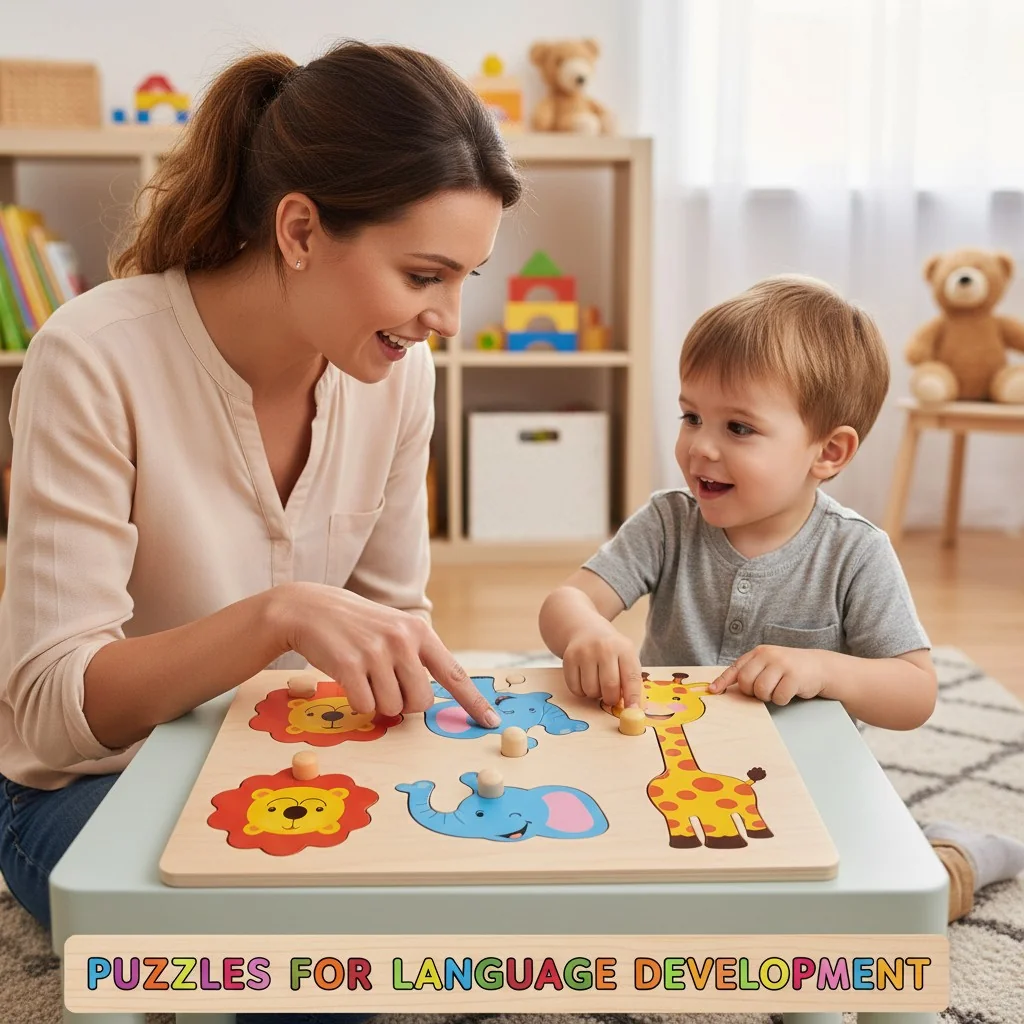
Dive deeper Paragraph:
Think beyond just shapes. A puzzle can be a farm, a city, or the solar system. When I was helping a client design a "daily routine" puzzle, we included pieces for waking up, eating breakfast, and going to bed. This simple theme gave parents a script to talk through the day with their child. The design itself becomes a conversation starter. From a manufacturing perspective, this is where you, the designer, need to be very specific in your tech pack. How will these images be applied? UV printing allows for vibrant, full-color images directly on the wood. Laser engraving creates a more natural, tactile look but is monochromatic. Screen printing is another option for simpler, bold graphics. Each method has different costs, durability, and setup requirements. Your choice will directly impact the final look and the manufacturer's quotation.
Image Application Methods on Wood
| Method | Pros | Cons | Best For |
|---|---|---|---|
| UV Printing | Full color, durable | Higher cost, requires flat surface | Detailed, colorful illustrations |
| Laser Engraving | Permanent, tactile feel | No color, potential for burn marks | Logos, letters, simple line art |
| Screen Printing | Cost-effective for large runs | Limited colors, less detail | Bold, simple graphics |
Children learn language best by listening to adults talk.False
While listening is important, language acquisition is most effective through active participation and interaction, such as the back-and-forth conversation prompted by playing with a thematic toy.
Thematic play, like using a farm animal puzzle, helps children build vocabulary in specific categories.True
By grouping objects into themes, children can more easily learn and remember new words, understand relationships between objects, and build a foundation for more complex language.
How Do You Integrate Letter Recognition into a Puzzle?
Alphabet blocks are a classic, but let's be honest, they can be a bit dull. You can make learning the ABCs a much more exciting and integrated part of playtime with a clever puzzle design.
You can weave letters into a puzzle by making the pieces into the shape of letters themselves. Or, you can print or engrave a letter onto a piece that matches an image. For example, an 'A' piece fits into an apple-shaped hole. This makes a fun, direct link between the letter and its meaning.
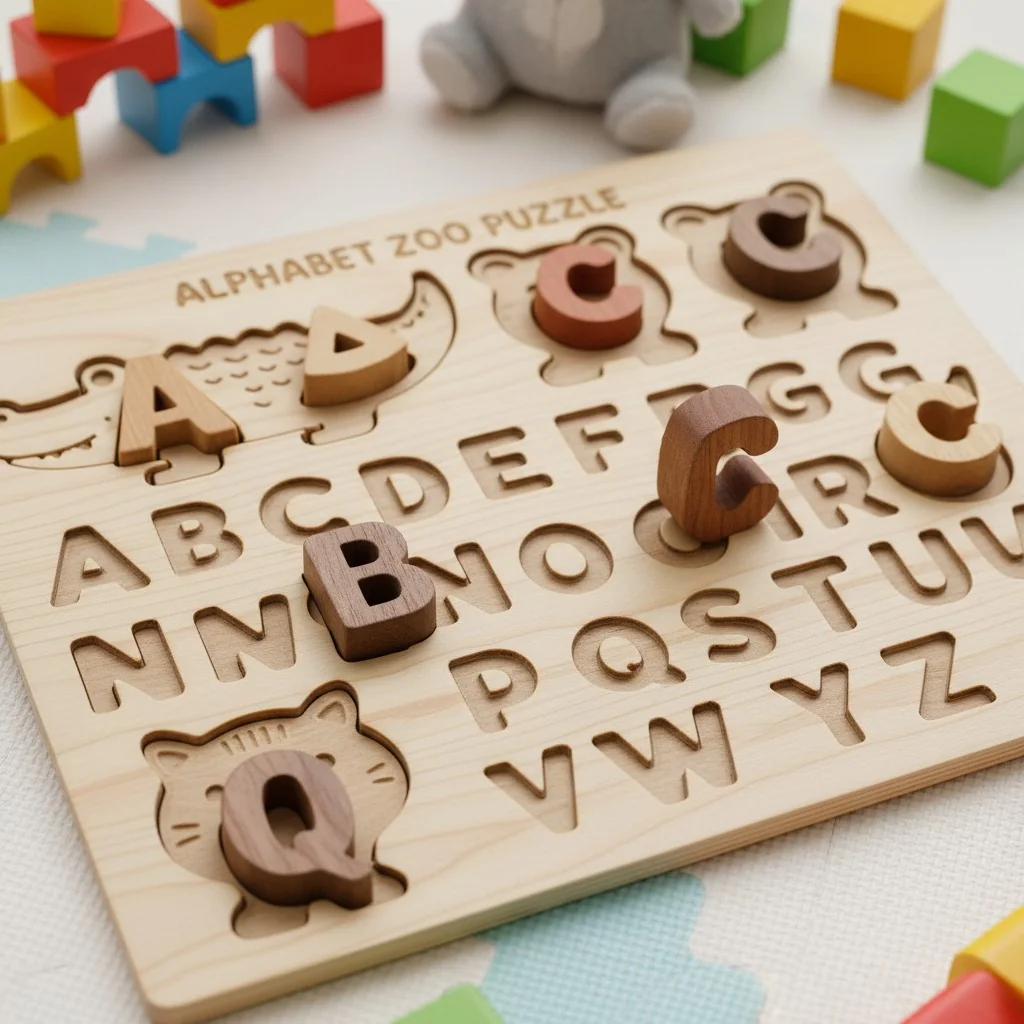
Dive deeper Paragraph:
When you're designing an alphabet puzzle, the details matter. I always advise clients to use a clear, simple, sans-serif font. This helps early learners recognize the basic form of each letter without any confusing decorative parts. You also need to decide between uppercase and lowercase letters, or maybe include both. From a manufacturing standpoint, creating puzzle pieces in the shape of letters requires precision CNC cutting. The 'kerf', or the width of the cut made by the laser or router bit, is critical. I once had a project where the supplier didn't account for the kerf properly. The letter pieces were too loose in their slots. We had to adjust the CAD files and remake the cutting templates. This is a perfect example of where your expertise as a designer, specifying exact tolerances, is crucial when working with any manufacturer, whether for plastic or wood.
Letter Integration Techniques
| Technique | Description | Key Design Consideration |
|---|---|---|
| Letter-Shaped Pieces | The puzzle pieces are the letters. | Structural integrity of thin letters (e.g., 'I'). |
| Engraved Letters | Letters are engraved on geometric pieces. | Font choice and engraving depth for tactility. |
| Match-the-Letter | A letter on a piece matches a letter on the board. | Clear visual link between piece and board. |
Children should only learn uppercase letters first.False
While uppercase letters are often easier to write, most written text is in lowercase. Experts recommend exposing children to both, as it helps them recognize letters in real-world contexts like books.
Sans-serif fonts are generally recommended for early-learning materials.True
Fonts without decorative 'serifs' (like Arial or Helvetica) have simpler, cleaner lines, making it easier for young children to distinguish and recognize individual letterforms.
How Can Puzzles Promote Cognitive Flexibility?
Most puzzles have one right answer. This is good for learning to follow instructions, but it doesn't teach creativity. How can your design encourage a child to think differently and solve problems in new ways?
You can build cognitive flexibility[^4] by designing open-ended puzzles. Use simple, geometric pieces that can be stacked and arranged in many different ways. You can also design puzzles with reversible pieces or multiple layers. This pushes kids to problem-solve instead of just matching shapes.
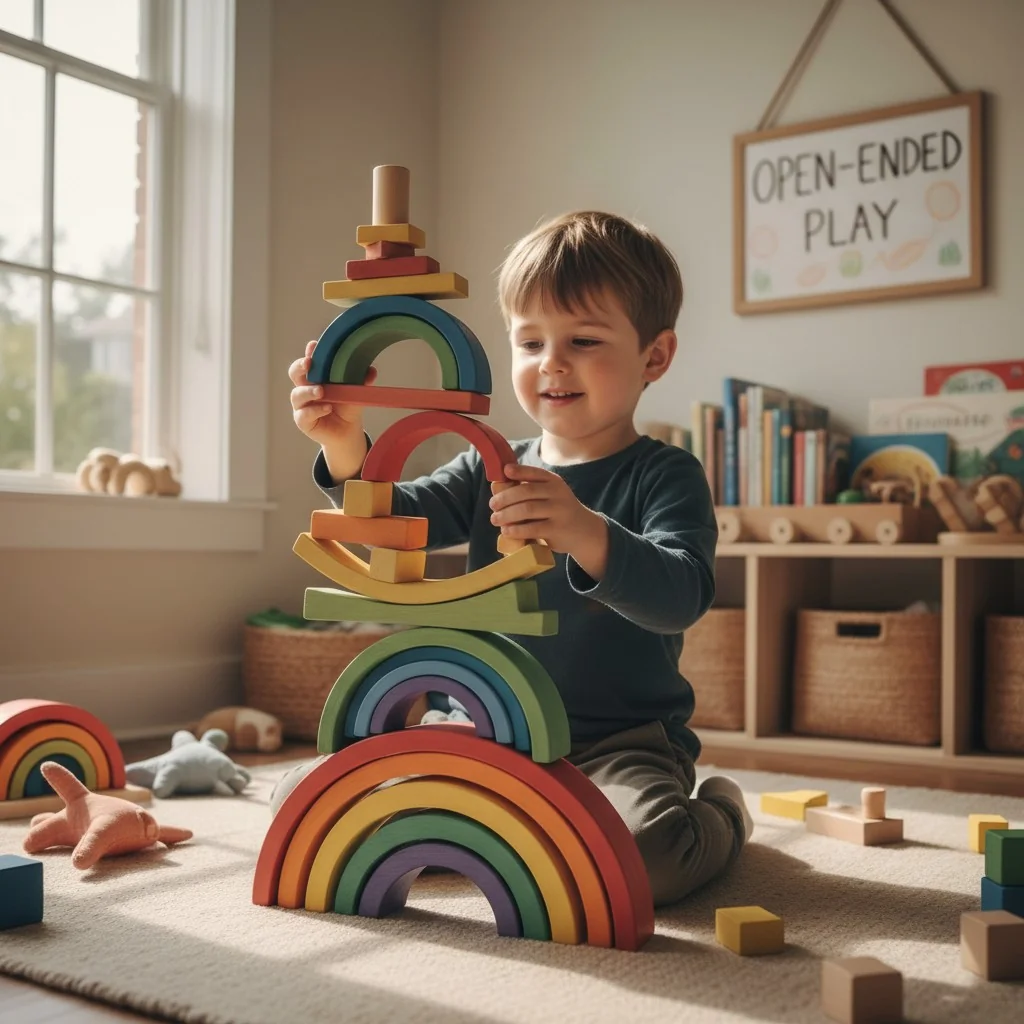
Dive deeper Paragraph:
The concept here is "open-ended play." The toy provides the tools, but the child directs the play. A classic example is a rainbow stacker. It can be a rainbow, but it can also be a tunnel, a bridge, or a fence for toy animals. As a designer, this means you focus on creating versatile, simple shapes that don't have just one purpose. Tangram puzzles are another great example. From a manufacturing perspective, this presents a different kind of challenge. For a stacking puzzle, the balance and consistency of the pieces are everything. Each piece must have a stable base and be manufactured to tight dimensional tolerances so they can stack without falling. This is very similar to ensuring that parts of a plastic enclosure snap together perfectly. It's all about precision and quality control, skills you already have as a mold designer.
Open-Ended vs. Closed-Ended Puzzles
| Puzzle Type | Goal | Child's Role | Key Skill |
|---|---|---|---|
| Closed-Ended | Complete a specific image or shape. | Follow a pre-determined solution. | Persistence, Shape Recognition |
| Open-Ended | Create, build, and imagine. | Invent new ways to use the pieces. | Creativity, Cognitive Flexibility |
Open-ended play is less educational than structured learning activities.False
Open-ended play is highly educational, fostering critical skills like problem-solving, creativity, and executive function that are difficult to teach in a structured way.
For stacking toys, the center of gravity of each piece is a critical design parameter.True
A well-designed stacking toy has pieces with a low and stable center of gravity to ensure they can be balanced in various configurations without easily toppling over.
Can a Solitary Toy Foster Social Engagement?
Puzzles are often seen as a quiet, solo activity. But with the right design, you can turn a puzzle into a tool that brings kids, friends, and families together for collaborative fun.
You can encourage social play by designing puzzles that are big enough for several kids to work on at once. Or, make the puzzle complex enough that it requires teamwork. You can also design the pieces to be used in turn-taking or matching games, which naturally promotes interaction.
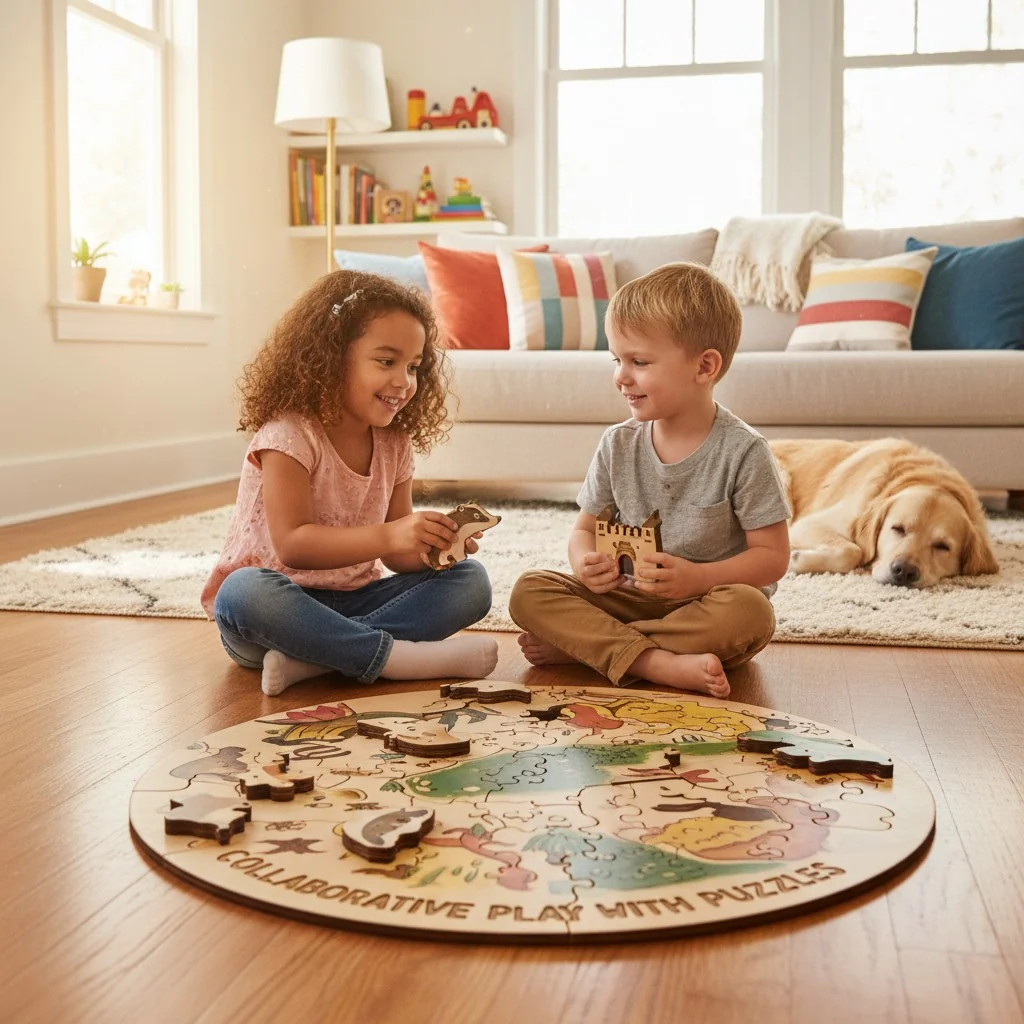
Dive deeper Paragraph:
The goal is to design for "cooperative play." I worked on a project for a large floor puzzle of a world map. Its size made it almost impossible for one small child to do alone. Kids naturally started working together, one finding the edge pieces while another looked for a specific country. You can also design puzzles with individual character pieces that can be used for role-playing after the puzzle is solved. When you're designing for group play, durability is non-negotiable. You need to specify a strong wood, like beech or rubberwood, that can handle being dropped or stepped on. Most importantly, you must be strict about safety certifications. When you source from China, you must demand and verify reports for standards like ASTM F963 (for the US) or EN71 (for Europe). This ensures the paints and materials are non-toxic and safe for everyone.
Toys that encourage cooperative play can help children develop empathy.True
When children work together towards a common goal, they learn to see things from others' perspectives, share ideas, and negotiate roles, all of which are foundational components of empathy.
ASTM F963 is a voluntary toy safety standard in the United States.False
While it started as a voluntary standard, the core provisions of ASTM F963 are mandatory for all toys sold in the U.S. under the Consumer Product Safety Improvement Act (CPSIA) of 2008.
How Do You Design for Inclusive Learning?
Many toys are unintentionally designed for a narrow range of abilities. This can leave children with developmental or physical challenges on the sidelines. A thoughtful designer can create toys that are fun and accessible for all.
To design for inclusive learning, use high-contrast colors for children with visual impairments. Add different textures and engraved lines for sensory feedback. And make sure the pieces are chunky and easy to grip for kids who struggle with fine motor skills. The key is clarity and accessibility.
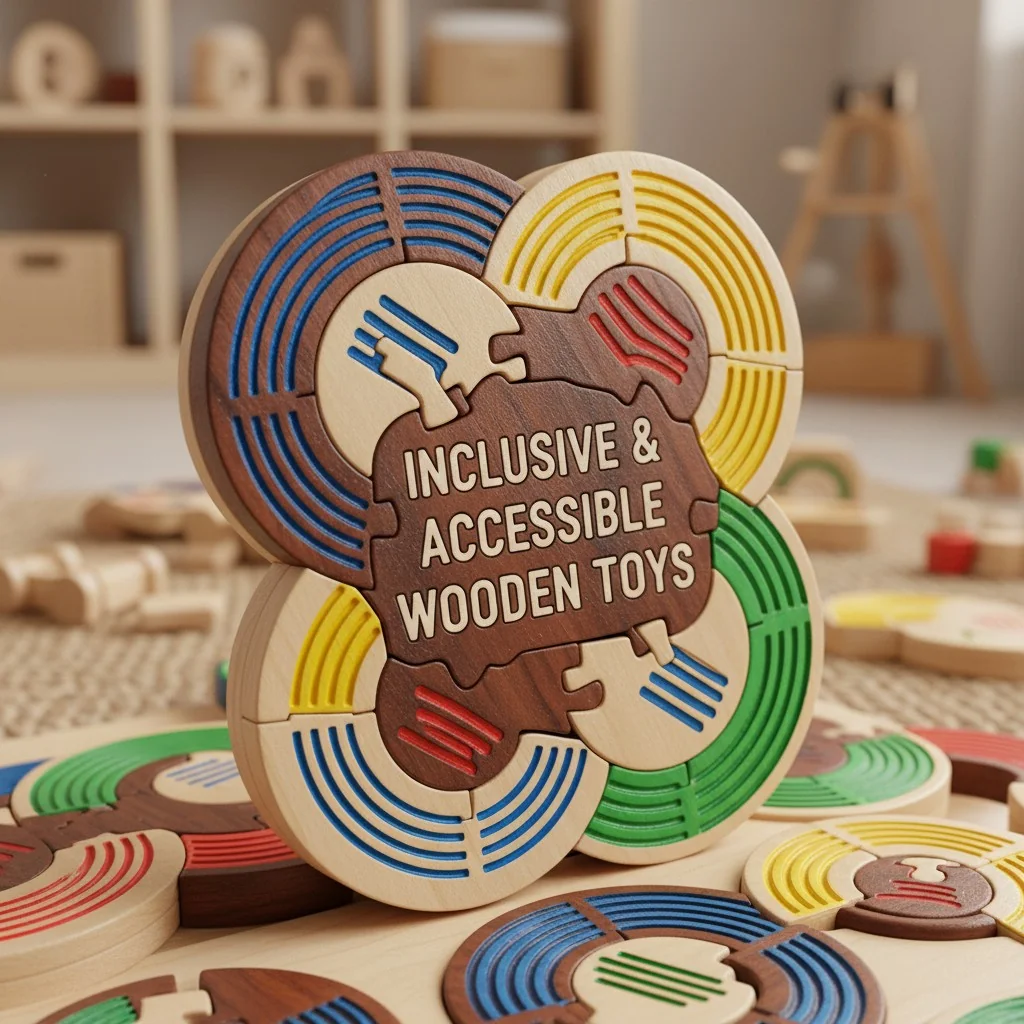
Dive deeper Paragraph:
inclusive design[^5] is about offering multiple ways for a child to engage with the toy. For a visually impaired child, high-contrast colors like black and white or yellow and blue are much easier to distinguish than subtle pastels. Adding tactile elements is also powerful. You can specify one piece be sanded perfectly smooth, another with engraved lines, and another with a rougher, natural grain. This sensory information helps all children, but it's especially critical for those who rely more on touch. For children with motor challenges, chunky pieces are better than small ones, and adding a large, simple knob can be the difference between being able to play or not. As a designer, you must clearly communicate these specific requirements to your manufacturer. Prototyping is essential here. You need to get a physical sample in your hands to feel the textures and test the grip yourself before you approve mass production.
High-contrast patterns are only beneficial for newborns.False
While newborns are highly responsive to high-contrast images, these patterns continue to be beneficial for all children, especially those with visual impairments, as they are easier for the brain to process.
Adding knobs to puzzle pieces makes them easier for all children to use.True
Knobs provide a larger, more defined gripping point, which aids children who are still developing their pincer grasp as well as children with motor skill difficulties.
Why is Tactile Tracing a Powerful Design Element?
Kids learn with their hands. A puzzle that is perfectly smooth and flat is missing a huge opportunity to engage the sense of touch, which is deeply connected to learning and memory.
tactile tracing[^6] is powerful because it uses muscle memory to reinforce learning. By engraving letters, numbers, or shapes into the wood, you create grooves. Children can trace these grooves with their fingers, creating a multi-sensory experience that makes learning stick.
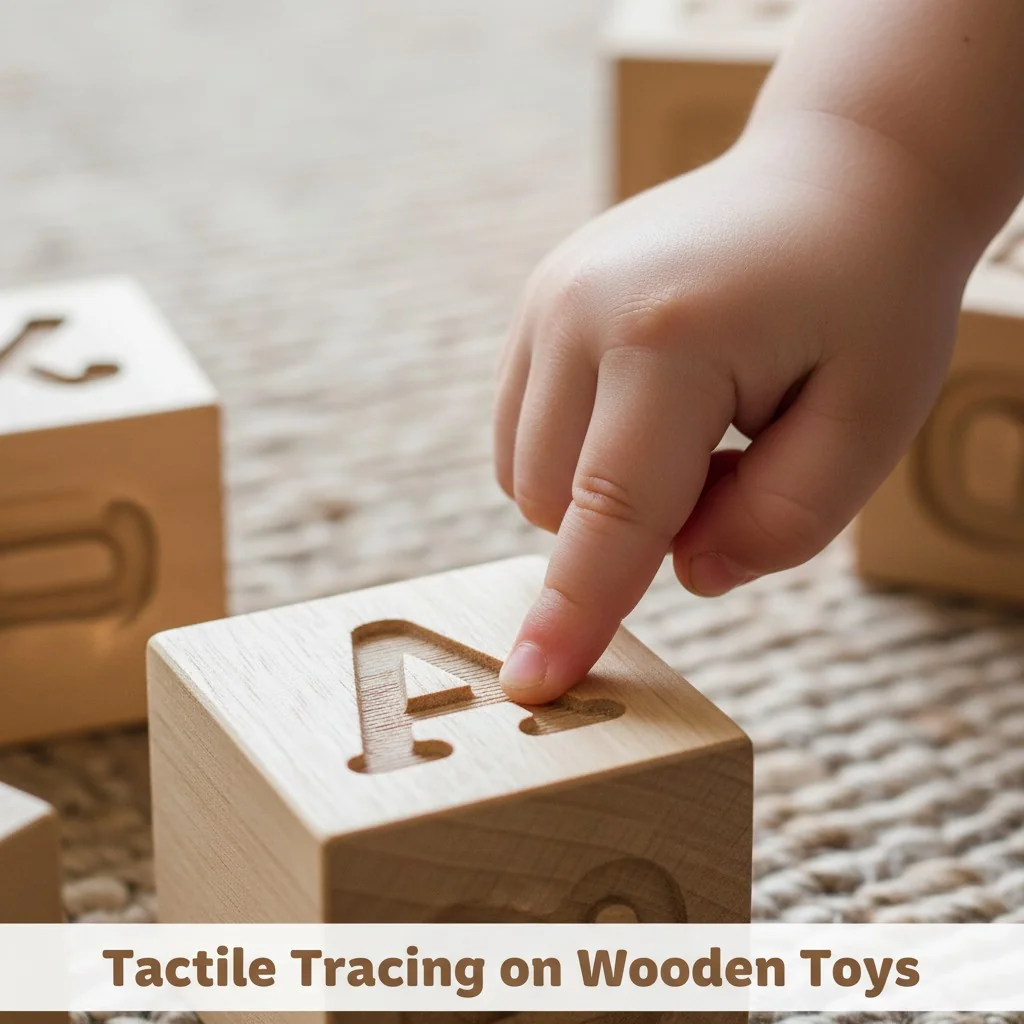
Dive deeper Paragraph:
This is all about haptic feedback—learning through touch. When a child traces the shape of the letter 'B', their muscles are learning the two loops and the straight line. It's a physical rehearsal for writing. As the designer, you control how effective this is. The grooves need to be just right. I recommend a depth of at least 1.5mm to 2mm. Any shallower, and the finger won't be guided effectively. Too deep or with sharp edges, and it becomes a safety or splinter hazard. This is a critical detail for your tech pack. You also need to specify the manufacturing method. Laser engraving is fast and precise for creating these grooves. A CNC router with a rounded bit can also be used to create a softer, wider channel. I've used both methods, and the choice depends on the desired feel and the manufacturer's capabilities.
Tactile Groove Design Specifications
| Age Group | Recommended Groove Width | Recommended Groove Depth | Rationale |
|---|---|---|---|
| 2-3 years | 3-4 mm | 2 mm | Wider groove for less developed motor control. |
| 4-5 years | 2-3 mm | 1.5-2 mm | Narrower groove to refine finger movement. |
Muscle memory is only relevant for sports and playing musical instruments.False
Muscle memory, or motor learning, is fundamental to many everyday activities, including handwriting. Tracing shapes and letters helps build the neural pathways required for this skill.
Laser engraving is always the best method for creating tactile grooves in wood.False
While laser engraving is excellent for precision, a CNC router with a ball-nose bit can create a wider, more rounded groove that can be more pleasant and effective for finger tracing.
結論
See? The leap from plastic molds to custom wooden toys isn't as big as it seems. By applying your core skills in DFM and supplier communication, you can successfully manage any project.
References
[^1]: Explore resources on designing custom wooden toys to enhance your skills and knowledge.
[^2]: Learn how DFM principles can improve your wooden toy designs and production efficiency.
[^3]: Discover how toy design can support children's fine motor development through play.
[^4]: Find out how puzzle design can encourage creative problem-solving in young minds.
[^5]: Learn about inclusive design strategies to create toys accessible for all children.
[^6]: Explore the benefits of tactile tracing in toys and its impact on children's learning.
